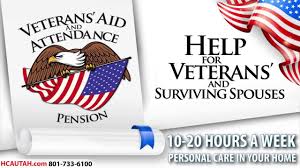Veterans’ Aid & Attendance
The Veterans’ Aid and Attendance (A&A) benefit is a little-known benefit for veterans and their families. This benefit can be used for care in an assisted living facility or for care at home. R. F. Meyer & Associates is pleased to include veterans’ benefits planning in its practice areas.
Veterans’ Aid & Attendance Benefit
What is Veterans’ A&A?
Title 38 Service Connected Benefits
Title 38 of the U.S. Code contains statutes regulating veterans’ benefit programs. Service-connected Veterans’ Compensation is provided to veterans for disabilities caused or exacerbated by military service, and it is normally expressed as compensation for a certain percentage disability.
Non-Service Connected Benefits
Non-service connected benefits (pensions) are available to veterans (and some widows or widowers) who meet certain conditions. The veterans do not have to be retired from military service, but the program is needs-based. The veteran must have served 90 days on active duty (the requirement is longer for more recent veterans), with at least one day during wartime, and have received a discharge under conditions other than dishonorable. The veteran must be “permanently and totally disabled” because of a non-service connected condition, or be over the age of 65 years. Additionally, for the improved pension program, the veteran’s income cannot exceed $931 per month (with no dependents) or $1,220 per month (with one dependent), the current maximum annual pension rate (MAPR).
The A&A benefit is an increased benefit for veterans who require “care or assistance on a regular basis” to protect them from dangers in their daily living environment. Veterans living in assisted living facilities are presumed to need this level of assistance, but the veteran should include a letter from the veteran’s personal physician regarding the veteran’s disability.
A&A increases income limit
The need for A&A increases the income limit from $931 per month to $1,554 per month (with no dependents), and from $1,220 per month to $1,842 per month (with one dependent). The MAPR for the A&A benefit, therefore, is the higher of $1,554 or $1,842 per month (widows or widowers can receive a maximum of $998 per month). One significant feature of the pension program is that income is reduced by paid-but-unreimbursed medical expenses, including insurance premiums, Medicare premiums, prescriptions, dental and vision care, and the costs of an assisted living facility, in-home aid, or adult day care. In many cases, these costs can easily reduce the applicant’s income to a level that would permit the applicant to receive the benefit.
Net worth considerations
The net worth of the applicant also is considered in the evaluation for A&A. There are no hard and fast rules, but a net worth below $80,000 for a couple or $50,000 for an individual has been acceptable. The VA looks to the net worth at the time of the application and there is no penalty period for the transfer of assets. If the veteran, however, transferred property that produced a great deal of income on the previous year’s tax return, that previous year’s higher income would be reflected on the application and may affect eligibility.
Further, because the lack of a penalty for transferring asset conflicts with Medicaid requirements, elder law attorneys should advise their clients of this disconnect and plan accordingly. The A&A benefit payments are made directly to the veteran or eligible surviving spouse, and they are specifically excluded from the definition of income for Medicaid purposes. The benefit is reduced to $90 per month if the veteran lives in a nursing home.
Find VA nursing homes in your state
For a list of your state’s VA nursing homes, please click here.
Contact the experienced Elder Law Attorneys at R. F. Meyer & Associates if we can help you incorporate Veterans’ Aid & Assistance benefits in your estate planning.
Arrange a free 15-minute phone consultation
Fill out the form below and we’ll be back in touch shortly, to schedule your free call. The brief consultation should allow us to frame the issues, and for us to to provide a price estimate for any recommended legal work.
